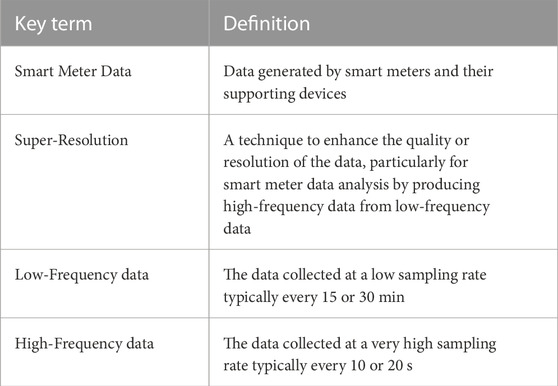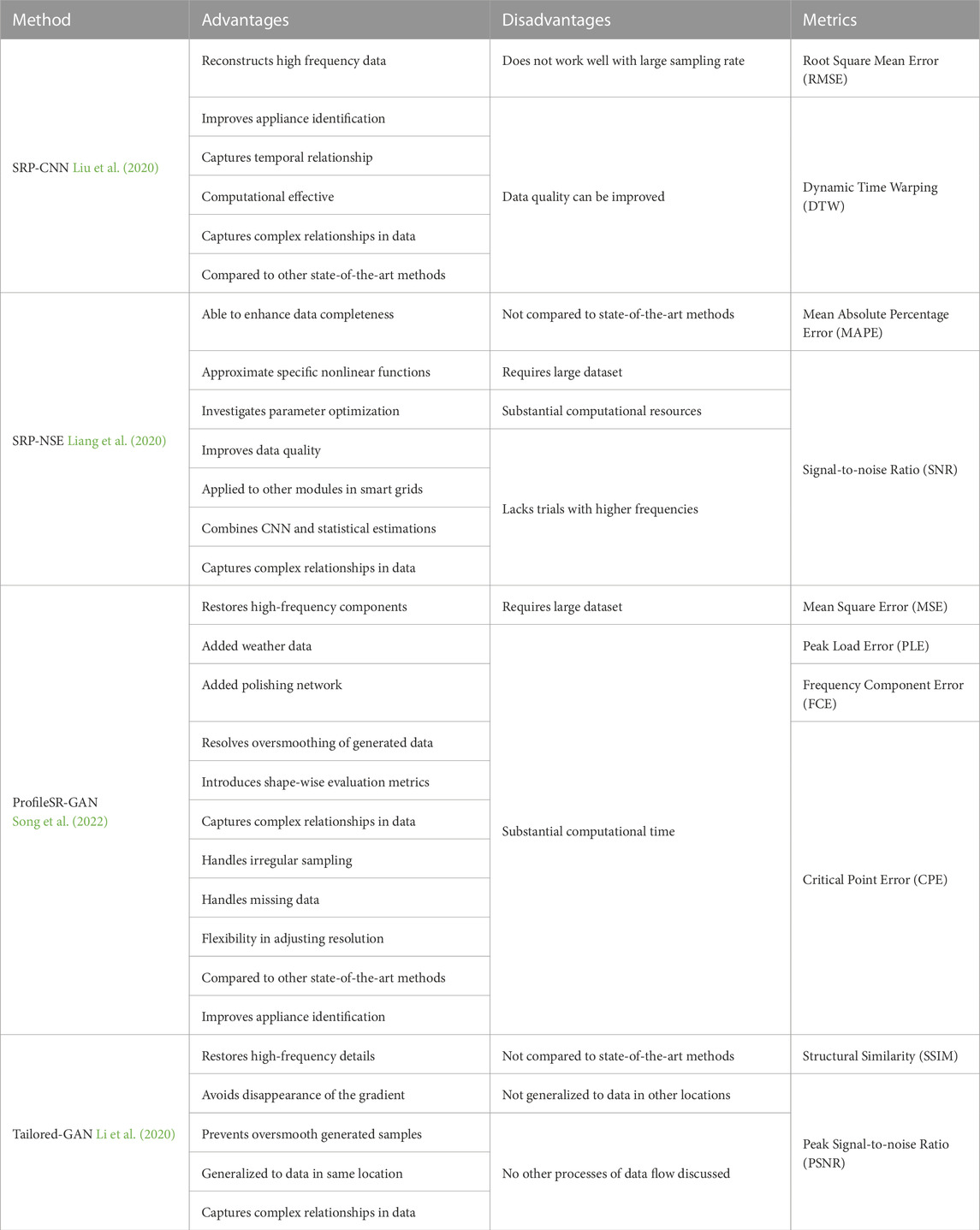- Department of Computer Science, Electrical Engineering and Mathematical Sciences, Western Norway University of Applied Sciences, Bergen, Norway
This paper presents a comprehensive review of super-resolution methods for smart meter data analysis. Smart meters provide valuable insights into household electricity consumption, but their low-frequency data limits the ability to capture detailed patterns. Super-resolution techniques address this challenge through the reconstruction of high-resolution data from low-resolution measurements. The review covers both non-machine learning-based methods (interpolation, signal processing, and statistics) and machine learning-based methods (CNNs, GANs). Four selected methods are discussed in detail, highlighting their principles, advantages, and limitations. These methods demonstrate superior accuracy in enhancing data completeness, capturing complex relationships, and improving resolution. The review contributes to the advancement of super-resolution techniques for smart meter data analysis, providing researchers and practitioners with valuable insights for efficient energy management and forecasting.
1 Introduction
Smart meters have revolutionized the monitoring of household electricity consumption, paving the way for more efficient and reliable electricity grids (Chen et al., 2023; Rind et al., 2023). These devices collect data at regular intervals, typically every 15 min or an hour, providing valuable insights into household consumption patterns. As of 2020, the International Energy Agency (IEA) reported that around 880 million smart meters were installed worldwide, representing approximately 43% of all electricity meters (Agency, 2021). While countries like Italy, Sweden, and the Netherlands have embraced smart meters, others have been slower in their adoption due to various factors. Nevertheless, the demand for improved energy consumption practices that are both efficient and sustainable is driving the continued deployment of smart meters (Tham and Luo, 2013; Ahmad et al., 2022).
The introduction of smart meters has transformed electric utilities into information management businesses within a relatively short period (Albert and Rajagopal, 2013a). This evolution has been made possible by the significant increase in data generated by meters and their supporting network devices. For instance, a utility with one million meters that collects hourly readings can generate over 2 terabytes of new production environment data annually (MichaelSteven Rogers, 2021). Consequently, smart meter data has been integrated with various systems, including outage systems, geospatial systems, asset management systems, weather data, and operational systems. This integration enables near-real-time insights into the status of the distribution grid’s system health, providing utilities with valuable information for proactive management. Some utilities have leveraged high-level analytics based on retrieved data from meters to predict failures in field equipment, such as transformers, while others have utilized the data to detect instances of electricity theft by identifying customers who tamper with the meter (McHenry, 2013; Martins et al., 2019).
High-resolution data collected from smart meters at sub-minute or few-second intervals offers significant advantages for electric utilities compared to traditional smart meter data collected at hourly or 15-min intervals. One key benefit is the ability to obtain a more rigorous understanding of energy consumption patterns, which enables precise predictions of energy demand. This empowers utilities to enhance energy efficiency, reduce costs for consumers, and make informed decisions regarding energy generation and distribution (Liu et al., 2020). Additionally, high-resolution data allows utilities to respond swiftly and accurately to changes in energy demand through automated adjustments during peak periods. This proactive approach helps prevent grid overload, mitigates the risk of blackouts, and reduces the reliance on expensive backup power sources (Reinhardt and Pereira, 2021; Suriyan et al., 2023).
Moreover, high-resolution data enables accurate load modeling, especially for integrating new loads such as electric vehicles and renewable energy sources. The real-time load characteristics obtained from high-resolution data enhance the accuracy and reliability of load forecasting, particularly for short-term predictions. It also enhances consumer engagement for electric vehicle adaptation and management in the grid (Mohanty et al., 2022).
Another significant application of high-resolution smart meter data lies in appliance identification and demand response programs. By utilizing per-second or higher-frequency data, utilities can identify individual appliances and observe their power consumption patterns (Devlin and Hayes, 2019). This information is invaluable for effective load management, non-intrusive load monitoring, and optimizing energy consumption in both commercial and residential buildings. Building owners can implement load-shedding strategies, minimize electricity costs, and make informed decisions regarding energy-efficient practices, tariff optimization, and load scheduling (Chen et al., 2019).
However, collecting high-frequency smart meter data at sub-minute or second-based intervals presents practical challenges. The sheer volume of data generated at such high frequencies can strain data storage, cloud space, and processing resources, resulting in increased costs for utilities and building owners. Additionally, the existing deployment of low-frequency meters in power grids makes complete meter replacement costly and inefficient.
To overcome these challenges, super-resolution methods have emerged as a crucial solution. These methods enable the reconstruction of high-resolution smart meter data from the available low-resolution data. By employing advanced algorithms and statistical modeling, super-resolution techniques enhance the degree of specificity and accuracy in the reconstructed data, effectively simulating high-frequency measurements. This approach significantly reduces data transmission and storage costs since only the low-frequency data needs to be transmitted, saving valuable bandwidth and storage resources. The reconstructed high-resolution data is capable of being generated in the data center by leveraging the low-frequency data and applying super-resolution algorithms (Kaselimi et al., 2022) as illustrated in Figure 1.
Furthermore, investing in robust communication infrastructure is essential to fully leverage the benefits of high-resolution smart meter data. Existing communication networks in the power industry may be inadequate for efficiently handling the vast amounts of data generated by high-frequency smart meters. Upgrading to high-speed broadband networks or implementing dedicated communication channels specifically designed for high-frequency data transmission is necessary to ensure seamless and reliable data flow (Ye et al., 2023a).
By overcoming the challenges associated with collecting high-frequency data and harnessing the capabilities of super-resolution methods, electric utilities, and building owners can fully embrace the advantages offered by high-resolution smart meter data. These advantages include improved energy management, optimized load distribution, accurate forecasting, and enhanced grid reliability (Ye et al., 2023b).
Despite the significant progress within the domain of super-resolution for smart meter data, there remains a noticeable research gap in terms of comprehensive review papers. Therefore, in this paper, we present a comprehensive overview of various super-resolution methods for smart meter data. Such methods can be categorized into two main groups: non-machine learning-based methods and machine learning-based methods. Non-machine learning methods involve techniques such as interpolation, signal processing, and statistical modeling. These methods utilize established mathematical and statistical principles to estimate high-frequency data points from available low-frequency measurements. On the other hand, machine learning methods have gained significant attention in smart meter data super-resolution because of their potential to learn complex patterns and correlations within the data. These methods offer powerful tools for producing high-resolution data from low-resolution measurements. By exploring the advancements in both non-machine learning and machine learning techniques, the primary aim of this paper is to provide a comprehensive understanding of the different approaches and their applications in smart meter data super-resolution.
The organization of this paper is as follows. Section II provides an overview of state-of-the-art approaches for smart meter data super-resolution. Section III delves into a detailed explanation of four selected methods that have demonstrated high performance based on their reported results. Section IV discusses the insights of selected methods as well as provides an overview of the advantages and disadvantages of each method. Finally, Section V concludes the paper, summarizing the key findings in the field of smart meter data super-resolution.
2 State-of-the-art methods
This section provides a summary of the different methods for smart meter data super-resolution, categorized into non-machine learning methods and machine learning methods. Both non-machine learning and machine learning methods have their strengths and weaknesses. Non-machine learning methods are often computationally efficient and straightforward to implement, making them suitable for simple super-resolution tasks. However, they may struggle to capture complex dependencies and variations in the data. Conversely, Machine learning methods can handle complex data relationships and generate highly accurate high-resolution data. However, they necessitate substantial quantities of data and computational resources.
In the literature, the super resolution for increasing the resolution or quality of the data can be referred to by other names or terms. Some alternative terms include time series upsampling, interpolation, imputation, enhancement, and reconstruction among other terms. These terms capture various aspects of the same process of increasing the frequency or detail of the time series, estimating missing values, or improving the overall quality of the data.
In the following subsections, we will provide a more detailed exploration of specific methods within each category, highlighting their key principles, advantages, and limitations in the context of smart meter data super-resolution. Major key terms used in the paper are illustrated in Table 1.
Overall, the selection of method depends on factors such as the nature of the data, desired accuracy, computational complexity, and available resources. Researchers often explore a combination of these methods or propose novel techniques to further advance the accuracy and efficiency of super-resolution for smart meter data.
2.1 Non-machine learning-based methods
In the realm of non-machine learning-based methods for smart meter data super-resolution, various interpolation, statistics, and signal processing-based techniques are commonly employed. These approaches utilize established mathematical principles to estimate high-frequency data points based on the available low-frequency measurements.
One commonly used category of non-machine learning-based methods is interpolation-based methods, which fills the gaps between the measurements to generate a higher-resolution dataset. Linear and non-linear interpolation methods estimate the high-frequency data points by assuming specific relationships (linear or non-linear) between the known low-frequency data points. These methods estimate the missing values by considering the neighboring measurements and assuming a smooth transition between them (Karger et al., 2020; Xiang et al., 2022). The Patidar et al. (2022); Jia et al. (2023) presented examples of interpolation-based methods for smart meter’s data super-resolution.
Interpolation methods are straightforward to implement and computationally efficient. Shortcomings of interpolation-based methods for time series super-resolution include smoothing effects, limited ability to capture complex patterns, difficulty handling missing data and irregular sampling, sensitivity to outliers, and assumptions of uniformly spaced data.
Signal processing-based methods, such as Fourier analysis, wavelet transforms, Filter Banks, and Singular Spectrum Analysis (SSA) are also utilized in smart meter data super-resolution. These methods extract additional information from the low-frequency data to enhance the resolution. Fourier analysis decomposes the signal into different frequency components, enabling the reconstruction of higher-frequency data by extrapolating from the observed low-frequency data. Toktarova et al. (2019); Cui et al. (2022); Al-Otaibi et al. (2016) are examples of electricity demand data upsampling using Fourier analysis. Wavelet transforms, on the other hand, allow for a localized analysis of the data that exist in the time and frequency domains. Methods based on Wavelet transforms for super-resolution analyze the observed low-frequency data at multiple scales and estimate the missing high-frequency details by reconstructing the signal at a higher resolution (Zhu and Mather, 2018; Amato et al., 2021). Filter banks are used to decompose a time series into multiple subbands based on different frequency ranges. In time series super-resolution, filter bank-based methods can be utilized to enhance the resolution by estimating the missing high-frequency data in each subband (Harris et al., 2015; Jimenez-Aparicio et al., 2022). Singular Spectrum Analysis-based methods can be applied in time series super-resolution to reconstruct the missing high-frequency data points based on the identified singular components (Liu et al., 2018).
These signal processing techniques leverage the inherent characteristics of the data to estimate missing values and improve the overall resolution. Shortcomings of signal processing approaches for time series super-resolution include assumptions of stationarity, limited modeling flexibility, difficulty in handling nonlinear relationships, sensitivity to noise, and challenges with irregular sampling (Sdraka et al., 2022).
Statistical-based methods, including state space models and autoregressive models are another category of non-machine learning-based methods for super-resolution. These models capture the temporal dependencies and statistical properties of the data to generate high-resolution estimates. State space approaches such as Hidden Markov Models (HMM), and Kalman Filter separates the observed data from the unobserved states, allowing for more accurate estimation of the missing high-frequency data points using observed measurements and model dynamics (Pham et al., 2021; Albert and Rajagopal 2013b; Alzaatreh et al., 2018; Leyli-Abadi et al., 2018; Nguyen et al., 2018). In state-space models, parameters are estimated from the past data.
Autoregressive models utilize past observations to predict future values, while hidden Markov models consider the underlying states and transitions in the data. Autoregressive methods typically involve autoregressive integrated moving average (ARIMA) and Seasonal AutoRegressive Integrated Moving Average (SARIMA) models. Autoregressive approaches are built on the temporal correlation of the data and utilize the autocorrelation and partial autocorrelation functions to predict the upcoming data points based on the past data (Blomgren et al., 2002). The method proposed by Hong et al. (2014) is an example of ARIMA application for smart meter super-resolution.
These statistical models give an understanding of the specific statistical properties of the data and can be useful for forecasting and estimation tasks. Despite their simplicity and efficiency, statistical-based methods can be sensitive to noise, have limited ability to capture nonlinear relationships, and may not capture complex patterns in the data.
Under the non-machine learning methods umbrella, the statistical methods may be preferred over machine learning-based methods in situations where the dataset is relatively small, and the underlying relationships can be adequately captured by established statistical techniques. They may also require less computational resources and have fewer dependencies on large training datasets. Additionally, statistical methods may be favored when there is a need for transparency, explainability, or regulatory compliance in decision-making processes such as real-time load monitoring or smart meter data quality assessment and visualization.
2.2 Machine learning-based methods
Machine learning-based methods have gained significant attention in smart meter data super-resolution due to their capacity to comprehend intricate patterns and connections within the data. These methods involve training algorithms and models on a large dataset of low-frequency and high-frequency data pairs. By learning the underlying patterns, machine learning models can generate high-resolution data from low-resolution measurements.
One popular approach involves employing deep learning models, like convolutional neural networks (CNNs) or recurrent neural networks (RNNs). CNNs are effective at capturing spatial dependencies in the data, while RNNs are suitable for capturing temporal dependencies. These deep learning models are highly proficient at capturing intricate relationships and variations in the data, leading to highly accurate high-resolution results (Hayat, 2018; Sdraka et al., 2022). The Liu et al. (2020); De-Paz-centeno et al. (2021) utilized CNN-based super-resolution methods for smart meter data. The Massaferro et al. (2022) presented a deep learning framework combined by wavelet decomposition for super-resolution of time series data. The Shi et al. (2017) developed an RNN approach for household high-resolution load forecasting. The Wang et al. (2021) suggested a mixed deep learning approach that incorporates long short-term memory (LSTM) and gated recurrent unit (GRU) networks to improve super-resolution performance for power distribution network measurements. In a similar study, Liang et al. (2020) developed a hybrid approach using LSTM and extreme learning machine (ELM) for high-resolution state estimation in power systems.
Generative Adversarial Networks (GAN) are a recent family of deep learning methods that perform highly in super-resolution and time series forecasting tasks. The following research papers (Li et al., 2020; De-Paz-centeno et al., 2021; Zhang et al., 2021) proposed GAN-based methods for smart meter’s super-resolution problem.
Ensemble methods combine multiple models to generate high-resolution estimates. For example, random forests utilize decision trees to capture different aspects of the data (Salvador and Perez-Pellitero, 2015; Schulter et al., 2015), while gradient-boosting algorithms iteratively improve the predictions by combining weak learners. Ensemble methods leverage the collective knowledge of multiple models to enhance the resolution and improve accuracy. Mocanu et al., (2016) proposed a super-resolution method for time series data based on an ensemble of deep learning, compressive sensing, and sparse representation that outperformed Artificial Neural Networks (ANN) and Recurrent Neural Networks (RNN).
Machine learning-based methods offer the advantage of capturing complex patterns and nonlinear relationships in data. They are particularly useful for tasks that require highly accurate predictions, such as dynamic load modeling or short-term load forecasting. However, they typically require a larger amount of training data and computational capabilities for training and predictions in comparison to non-machine learning methods.
Understanding the distinctions between non-machine learning-based methods and machine learning-based methods is crucial in selecting the most appropriate approach for smart meter data super-resolution. Factors such as data set size, computational resources, interpretability requirements, and the specific objectives of the analysis should be considered when determining which category of methods is more suitable for a given application.
3 Unveiling the inner workings of four selected super-resolution methods
This section provides a more detailed explanation of four machine learning based methods for super-resolution in smart meter data. These methods have been selected based on their relevance and effectiveness in the domain of smart meter data super-resolution. Each method is described below, highlighting its key principles, advantages, and limitations.
3.1 SRP-CNN
The study conducted by Liu et al. (2020) presents a time-series super-resolution method specifically designed for smart meter data called Super Resolution Perception Convolutional Neural Network (SRPCNN). This method utilizes a perception-based super-resolution framework that incorporates both low-level and high-level features of the data. It utilizes a CNN architecture that comprises of an encoder-decoder structure with skip connections to effectively get and restore the high-frequency details from the data. SRPCNN works as a feature extractor on low-frequency data. The process involves extracting features, followed by an information supplement network comprised of seven convolutional layers. This network performs non-linear mapping to transition from low-frequency to high-frequency feature spaces. The method leverages perceptual loss functions to align the generated high-resolution data with the actual data, enhancing the perceptual quality of the results. The SRPCNN network architecture of is illustrated in Figure 2.
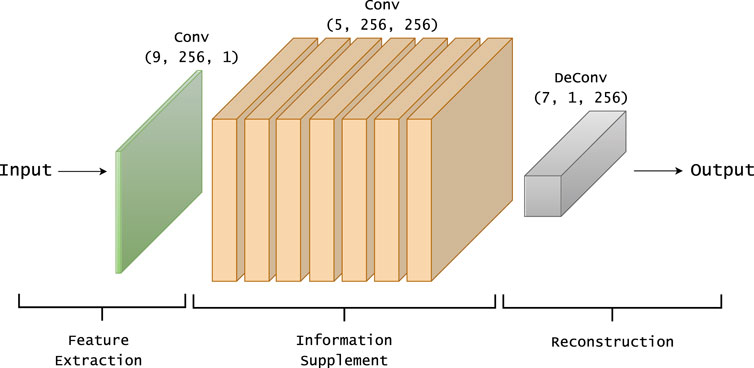
FIGURE 2. SRP-CNN network architecture (Liu et al., 2020).
The key principles of the method involve leveraging a perceptual loss function and training for super-resolution. The advantages of the method include its ability to capture complex relationships in the data and generate high-resolution load profiles. However, the method does not work well when there is a substantial disparity in the sampling rates between the low-frequency data and the high-frequency data.
In the experimental part, the authors utilized the proposed SRP method for generating high-frequency data from low-frequency data. They then compared the results with two classical interpolation methods: Cubic and Linear interpolation. Subsequently, the SRP dataset was evaluated using several baseline methods, including SVM and CNN. The results show that SRP-CNN outperforms these baseline methods, achieving higher accuracy in generating high-resolution load profiles.
3.2 SRP-NSE
In Liang et al. (2020), the authors propose a time-series super-resolution method for enhancing the completeness of data in smart grid state estimation. The method combines the strengths of CNN and statistical estimation techniques to generate high-resolution data. The CNN is trained using a combination of perceptual loss functions and adversarial learning to enhance the resolution of the input data.
The method offers several advantages, including its ability to generate high-resolution data with improved accuracy and completeness. However, the method requires a large dataset and substantial computational resources. Figure 3 illustrates the architecture of the method and the data transformation process.
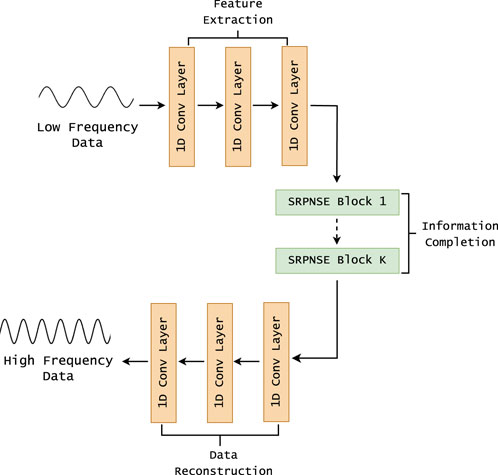
FIGURE 3. SRP-NSE framework network structure (Liang et al., 2020).
During the stage of feature extraction, the method employs three one-dimensional (1D) convolutional layers for extracting features from the low-frequency data. The information completion stage supplies higher resolutions of features from the relationship knowledge between low- and high-frequency data. The stage has multiple SRPNSE blocks executed using a residual structure. This residual structure is made up of one global residual connection and multiple local residual blocks. Figure 4 illustrates the structure of the residual blocks.
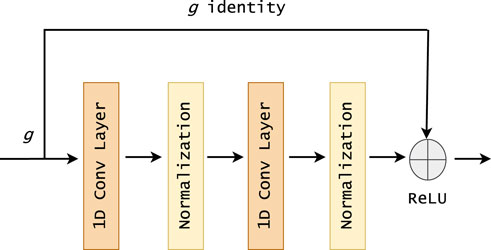
FIGURE 4. Network structure of the SRP-NSE blocks (Liang et al., 2020).
Regarding accuracy and performance, the paper compares SRP-NSE with other super-resolution methods, particularly linear interpolation, and cubic interpolation methods, demonstrating its superior performance in enhancing the completeness of data for smart grid state estimation tasks.
3.3 ProfileSR-GAN
Song et al. (2022) proposed a method that utilizes a generative adversarial network (GAN) framework for generating high-resolution load profiles from low-resolution data. The method applies to smart meter data by taking low-resolution load profiles obtained from smart meters as input and generating high-resolution load profiles with enhanced details.
The key principles of ProfileSR-GAN involve training a generator and a discriminator within the GAN framework. The generator takes low-resolution load profiles as input and generates corresponding high-resolution profiles, while the discriminator evaluates these generated profiles. Through adversarial learning, the generator learns to produce high-resolution profiles that are virtually identical to authentic ones, while the discriminator is trained to differentiate between real and generated profiles.
The method offers advantages such as capturing complex patterns and relationships in the data, handling irregular sampling intervals and missing values, and allowing flexibility in adjusting the desired resolution level. However, it may depend on the availability of a large and diverse training dataset and requires high computational resources. The architecture of the ProfileSR-GAN is presented in Figure 5.
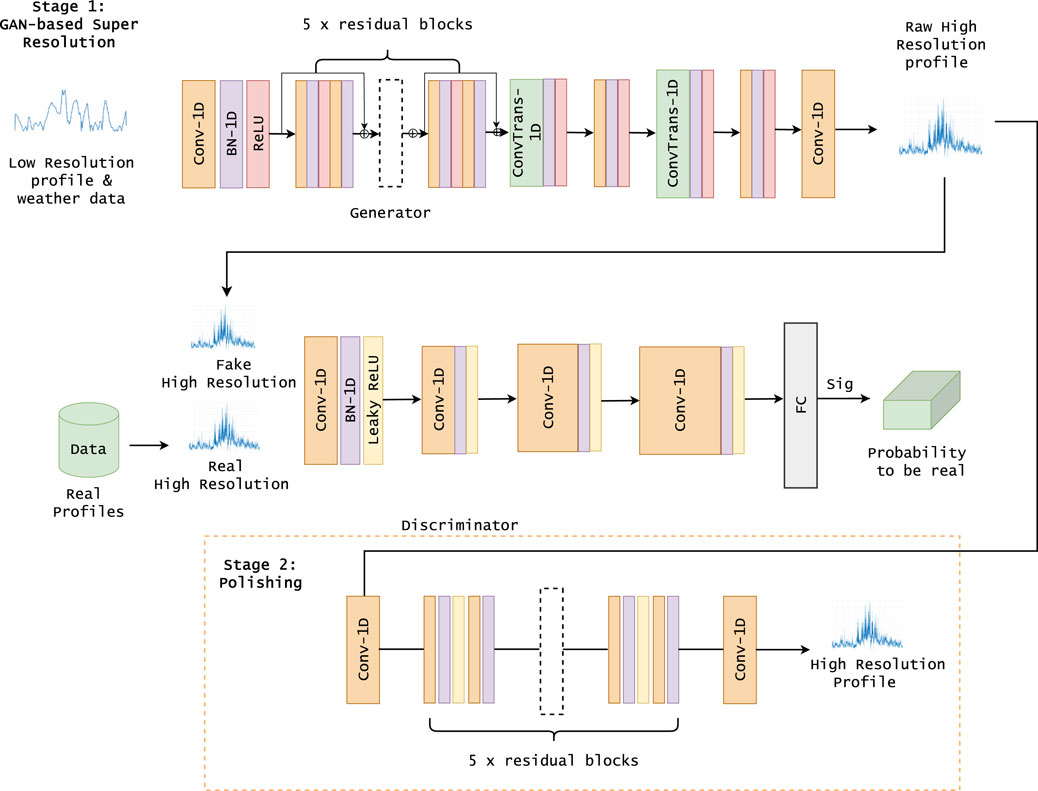
FIGURE 5. The 2-stage ProfileSR-GAN architecture (Song et al., 2022).
The accuracy and performance of ProfileSR-GAN are evaluated in comparison to other super-resolution methods, such as CNN. The paper demonstrates superior results in terms of quantitative metrics, such as peak signal-to-noise ratio and the visual quality of the generated high-resolution load profiles.
3.4 Tailored-GAN
The study conducted by Li et al. (2020) introduces a time-series super-resolution method employing a Generative Adversarial Network (GAN). The proposed method utilizes a GAN architecture, consisting of a generator and a discriminator, to learn the relationship between low-frequency and high-frequency measurements. The generator learns to generate high-resolution data from the low-resolution input, and the discriminator aims to determine the generated high-resolution data from the ground truth high-resolution data. The trained model can then generate high-resolution data from the low-resolution measurements captured by the smart meters, thus improving the overall data quality.
Figure 6 depicting the overview of the method, including the GAN architecture and the data transformation process, would provide a visual representation of ProfileSR-GAN.
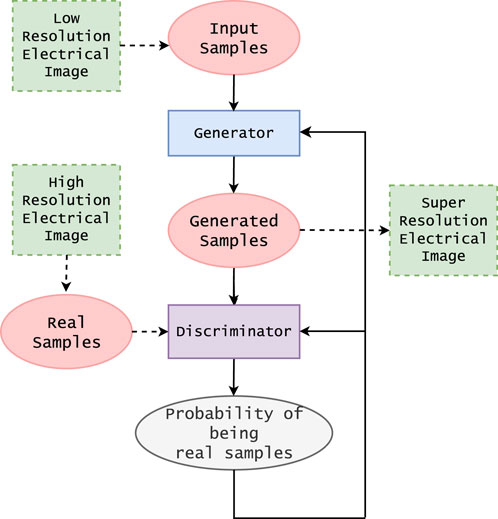
FIGURE 6. Network structure for Improved GAN. Li et al. (2020).
The advantages of the proposed approach include the ability to generate high-quality, high-resolution data from low-frequency measurements, thereby enhancing super-resolution accuracy. In addition, the validation by the authors shows that the method generalizes to datasets from the same area. However, generalization to other different geographical areas is limited.
Regarding accuracy and performance, the paper lacks a fair comparison with other state-of-the-art methods for super-resolution methods. However, it shows high performance in the upsampling of electric grid measurement data.
4 Discussion
Super-resolution algorithms for smart meter data provide solutions to the challenges associated with collecting high-frequency data. The selected algorithms, specifically designed for time-series super-resolution in smart grids and smart meters, use deep learning techniques such as GANs or CNNs. These deep learning methods are chosen for their ability to learn complex patterns in data and generate high-quality high-resolution outputs from lower-resolution inputs. All the reviewed methods focus on applications within smart grids, such as enhancing load forecasting, appliance identification, and improving the overall efficiency of electricity services. This shared focus underscores the growing importance of advanced data analysis techniques in energy management.
We want to emphasize the variety of approaches utilized in these methods. A strength of deep learning algorithms is their adaptability to various sources of data, tailoring the learning process to each specific application (Iglesias et al., 2022). For instance, the Tailored-GAN method (Li et al., 2020) processes data as images, demonstrating the flexibility of deep learning algorithms. While the overall goal of all methods is to improve data quality, the approaches to handle and enhance data vary. Some focus on the inclusion of weather data in the model, others on the generalization of models across different datasets and geographical locations, and some on the practical aspects of training deep learning models for super-resolution.
In this section, we will analyze the main advantages and disadvantages of the four selected methods. An overview of these four methods is illustrated in Table 2.
4.1 Advantages
Broadly speaking, it can be stated that the four chosen techniques are all capable of producing high-resolution data from low-resolution sources.
The SRP-CNN approach (Liu et al., 2020) demonstrated the ability to effectively reconstruct high-frequency data and increase the quality of low-frequency measurements, leading to significantly improved accuracy. The method also proved its effectiveness in enhancing the precision of appliance identification. Moreover, the design of SRP-CNN is designed to capture the temporal dynamics in one-dimensional time series data, aligning with the specific attributes of the SRP problem, in contrast to CNNs used for image processing. Additionally, the SRP-CNN solves the issue of computational inefficiency by using a fully convolutional network and parallel processing, enabling it to capture complex relationships within the data.
SRP-NSE (Liang et al., 2020) demonstrated its effectiveness and value in enhancing data completeness in smart grid state estimation tasks, compared to traditional super-resolution methods. The method employs a deep neural network with various residual blocks, providing the ability to approximate specific nonlinear functions effectively. To address the challenges associated with parameter optimization, the paper explores the effectiveness of the RMSProp and ADAM algorithms in enhancing the training process. Notably, the SRP-NSE method combines the capabilities of CNN with statistical estimation methods. Additionally, the SRP-NSE method improves data quality and can be applied to various other modules within smart grid systems.
The ProfileSR-GAN technique (Song et al., 2022) showed superior performance in the restoration of high-frequency components in sampling intervals. The notable advancements in its performance are primarily due to the addition of weather data as well as the fine-tuning of the added polishing network. Furthermore, the study employs a combination of adversarial and feature loss terms for the loss function of the generator, to resolve the issue of too smooth generated data. The research also introduces three innovative shape-wise evaluation metrics. Key advantages of the ProfileSR-GAN method include its proficiency in capturing complex patterns and relationships in the data and handling missing data and irregular sampling intervals in the preprocessing of the data. Additionally, the method provides flexibility in adjusting the desired resolution by adding a scale-up factor. Comparisons against both traditional interpolation and state-of-the-art CNN-based methodologies demonstrate the superiority of ProfileSR-GAN. Improved results in Non-Intrusive Load Monitoring (NILM) experiments further demonstrate the value of the method.
Tailored-GAN (Li et al., 2020) showed the ability to replace high-frequency features with better accuracy, compared to traditional super-resolution methods. These improvements are mainly due to the introduction of the Wasserstein distance, which helps prevent gradient vanishing and thereby boosts training stability. Another reason for the improvement is the introduction of perceptual loss to help prevent overly-smoothed generated samples and cautious restoration outcomes. Further, the model is capable of generalization to data from similar geographical areas.
4.2 Disadvantages
The four selected methods include various disadvantages highlighted in the form of limitations and future work.
SRP-CNN (Liu et al., 2020) struggles to function effectively because of significant information loss, should the sampling rate disparity between the low-frequency data and the high-frequency data be excessively wide. Put simply, executing super-resolution becomes more challenging as the SRP factor increases. Additionally, the authors of the paper mention that focusing on improving data quality, i.e., inferring missing data and detecting bad data, has a significant real-world value in future SRP experiments.
The SRP-NSE (Liang et al., 2020) method is compared to linear interpolation, cubic interpolation, and real downsampled data, but lacks comparison with other state-of-the-art super-resolution methods. Furthermore, the data used in the experiment is substantially large. Adding a more comprehensive dataset to the experiment would require substantial computational resources, requiring further hardware investments. Additionally, the authors of the paper suggest further work should include trials with relatively higher frequencies.
The ProfileSR-GAN (Song et al., 2022) method requires a substantial amount of data. Because of the amount of data and the nature of the GAN network, this method also requires extensive computational time. Furthermore, the authors suggest future work should include an evaluation of the method on various other time-series datasets.
The tailored-GAN method (Li et al., 2020) is only compared to bicubic interpolation, missing comparison to other state-of-the-art super-resolution methods. Furthermore, the method does not generalize well on data in different geographic areas. Lastly, the authors mention that the paper only examines the reconstruction of low-frequency measurement data and no other processes of data flow.
5 Conclusion
In this paper, we provided a comprehensive overview of super-resolution methods for smart meter data analysis. The increasing deployment of smart meters has produced an immense volume of data, but the low-frequency nature of this data restricts its ability to capture fine-grained patterns and detailed information. Super-resolution techniques have emerged as a valuable solution to overcome this limitation.
We categorized super-resolution methods into non-machine learning-based and machine learning-based approaches. Non-machine learning methods, such as interpolation, signal processing, and statistics, offer simplicity and computational efficiency but may struggle with capturing complex relationships. Machine learning methods, including CNNs and GANs, excel at capturing intricate patterns and generating high-resolution data but require substantial training data and computational resources.
We presented a detailed examination of four selected super-resolution methods: SRP-CNN, SRP-NSE, ProfileSR-GAN, and Tailored-GAN. These methods showcased the advancements in both non-machine learning and machine learning techniques, demonstrating their effectiveness in enhancing data completeness, capturing complex relationships, and improving resolution accuracy.
The research in smart meter data super-resolution is continually evolving, and there are opportunities for further exploration and improvement. Future research can focus on addressing the limitations of existing methods, developing hybrid approaches, and considering the scalability and generalizability of the techniques to different geographical areas and diverse datasets.
Overall, the advancements in super-resolution methods for smart meter data analysis hold great promise for improving energy management, load forecasting, and grid reliability. By leveraging these techniques, researchers and practitioners can gain deeper insights into household energy consumption patterns and make informed decisions for efficient and sustainable energy practices.
Author contributions
MI: Conceptualization, Formal Analysis, Investigation, Methodology, Validation, Visualization, Writing–original draft. MK: Conceptualization, Investigation, Project administration, Supervision, Validation, Visualization, Writing–review and editing. AM: Conceptualization, Project administration, Supervision, Validation, Writing–review and editing. RA: Conceptualization, Funding acquisition, Project administration, Resources, Supervision, Validation, Writing–review and editing.
Funding
The author(s) declare that no financial support was received for the research, authorship, and/or publication of this article.
Acknowledgments
We would like to sincerely thank the Volte Company for their technical insights and feedback. Their contribution was incredibly important in conducting this review study.
Conflict of interest
The authors declare that the research was conducted in the absence of any commercial or financial relationships that could be construed as a potential conflict of interest.
Publisher’s note
All claims expressed in this article are solely those of the authors and do not necessarily represent those of their affiliated organizations, or those of the publisher, the editors and the reviewers. Any product that may be evaluated in this article, or claim that may be made by its manufacturer, is not guaranteed or endorsed by the publisher.
References
Agency, I. E. (2021). Global ev outlook 2021: driving the transition to electric mobility. https://www.iea.org/reports/global-ev-outlook-2021.
Ahmad, T., Zhu, H., Zhang, D., Tariq, R., Bassam, A., Ullah, F., et al. (2022). Energetics systems and artificial intelligence: applications of industry 4.0. Energy Rep. 8, 334–361. doi:10.1016/j.egyr.2021.11.256
Albert, A., and Rajagopal, R. (2013a). Smart meter driven segmentation: what your consumption says about you. IEEE Trans. power Syst. 28, 4019–4030. doi:10.1109/tpwrs.2013.2266122
Albert, A., and Rajagopal, R. (2013b). Smart meter driven segmentation: what your consumption says about you. IEEE Trans. Power Syst. 28, 4019–4030. doi:10.1109/TPWRS.2013.2266122
Al-Otaibi, R., Jin, N., Wilcox, T., and Flach, P. (2016). Feature construction and calibration for clustering daily load curves from smart-meter data. IEEE Trans. Industrial Inf. 12, 645–654. doi:10.1109/TII.2016.2528819
Alzaatreh, A., Mahdjoubi, L., Gething, B., and Sierra, F. (2018). Disaggregating high-resolution gas metering data using pattern recognition. Energy Build. 176, 17–32. doi:10.1016/J.ENBUILD.2018.07.011
Amato, U., Antoniadis, A., Feis, I. D., Goude, Y., and Lagache, A. (2021). Forecasting high resolution electricity demand data with additive models including smooth and jagged components. Int. J. Forecast. 37, 171–185. doi:10.1016/J.IJFORECAST.2020.04.001
Blomgren, P., Papanicolaou, G., and Zhao, H. (2002). Super-resolution in time-reversal acoustics. J. Acoust. Soc. Am. 111, 230–248. doi:10.1121/1.1421342
Chen, M., Sanders, K. T., and Ban-Weiss, G. A. (2019). A new method utilizing smart meter data for identifying the existence of air conditioning in residential homes. Environ. Res. Lett. 14, 094004. doi:10.1088/1748-9326/AB35A8
Chen, Z., Amani, A. M., Yu, X., and Jalili, M. (2023). Control and optimisation of power grids using smart meter data: a review. Sensors 23, 2118. doi:10.3390/s23042118
Cui, Y., Yan, R., Sharma, R., Saha, T., and Horrocks, N. (2022). Realizing multifractality of smart meter data for household characteristic prediction. Int. J. Electr. Power Energy Syst. 139, 108003. doi:10.1016/J.IJEPES.2022.108003
De-Paz-centeno, I., García-Ordás, M. T., García-Olalla, O., Arenas, J., and Alaiz-Moretón, H. (2021). M-srpcnn: a fully convolutional neural network approach for handling super resolution reconstruction on monthly energy consumption environments. Energies 14, 4765. doi:10.3390/EN14164765
Devlin, M. A., and Hayes, B. P. (2019). Non-intrusive load monitoring and classification of activities of daily living using residential smart meter data. IEEE Trans. Consumer Electron. 65, 339–348. doi:10.1109/TCE.2019.2918922
Harris, F., Venosa, E., Chen, X., and Dick, C. (2015). Interleaving different bandwidth narrowband channels in perfect reconstruction cascade polyphase filter banks for efficient flexible variable bandwidth filters in wideband digital transceivers. Int. Conf. Digital Signal Process. DSP, 1111–1116. doi:10.1109/ICDSP.2015.7252051
Hayat, K. (2018). Multimedia super-resolution via deep learning: a survey. Digit. Signal Process. 81, 198–217. doi:10.1016/J.DSP.2018.07.005
Hong, T., Wilson, J., and Xie, J. (2014). Long term probabilistic load forecasting and normalization with hourly information. IEEE Trans. Smart Grid 5, 456–462. doi:10.1109/TSG.2013.2274373
Iglesias, G., Talavera, E., González-Prieto, Á., Mozo, A., and Gómez-Canaval, S. (2022). Data augmentation techniques in time series domain: a survey and taxonomy. arXiv preprint arXiv:2206.13508.
Jia, Y., Liang, Z., Huo, X., Chen, W., Chai, Y., and Yu, R. (2023). The impact of load-pv profile resolution on distribution system risk assessment. Energy Rep. 9, 2653–2664. doi:10.1016/J.EGYR.2023.01.079
Jimenez-Aparicio, M., Reno, M. J., and Pierre, J. W. (2022). “The high-resolution wavelet transform: a generalization of the discrete wavelet transforms,” in 2022 IEEE 13th Annual Ubiquitous Computing, Electronics and Mobile Communication Conference (UEMCON), 395–401. doi:10.1109/UEMCON54665.2022.9965716
Karger, D. N., Schmatz, D. R., Dettling, G., and Zimmermann, N. E. (2020). High-resolution monthly precipitation and temperature time series from 2006 to 2100. Sci. Data 7, 248–310. 1 7. doi:10.1038/s41597-020-00587-y
Kaselimi, M., Protopapadakis, E., Voulodimos, A., Doulamis, N., and Doulamis, A. (2022). Towards trustworthy energy disaggregation: a review of challenges, methods, and perspectives for non-intrusive load monitoring. Sensors 22, 5872. doi:10.3390/S22155872
Leyli-Abadi, M., Same, A., Oukhellou, L., Cheifetz, N., Mandel, P., Feliers, C., et al. (2018). “Mixture of non-homogeneous hidden markov models for clustering and prediction of water consumption time series,” in Proceedings of the International Joint Conference on Neural Networks. doi:10.1109/IJCNN.2018.8489473
Li, F., Lin, D., and Yu, T. (2020). Improved generative adversarial network-based super resolution reconstruction for low-frequency measurement of smart grid. IEEE Access 8, 85257–85270. doi:10.1109/ACCESS.2020.2992836
Liang, G., Liu, G., Zhao, J., Liu, Y., Gu, J., Sun, G., et al. (2020). Super resolution perception for improving data completeness in smart grid state estimation. Engineering 6, 789–800. doi:10.1016/j.eng.2020.06.006
Liu, C., Akintayo, A., Jiang, Z., Henze, G. P., and Sarkar, S. (2018). Multivariate exploration of non-intrusive load monitoring via spatiotemporal pattern network. Appl. Energy 211, 1106–1122. doi:10.1016/J.APENERGY.2017.12.026
Liu, G., Gu, J., Zhao, J., Wen, F., and Liang, G. (2020). Super resolution perception for smart meter data. Inf. Sci. 526, 263–273. doi:10.1016/J.INS.2020.03.088
Martins, J. F., Pronto, A. G., Delgado-Gomes, V., and Sanduleac, M. (2019). Smart meters and advanced metering infrastructure. Pathw. a Smarter Power Syst. 89, 89–114. doi:10.1016/B978-0-08-102592-5.00004-1
Massaferro, P., Martino, J. M. D., and Fernandez, A. (2022). Fraud detection on power grids while transitioning to smart meters by leveraging multi-resolution consumption data. IEEE Trans. Smart Grid 13, 2381–2389. doi:10.1109/TSG.2022.3148817
McHenry, M. P. (2013). Technical and governance considerations for advanced metering infrastructure/smart meters: technology, security, uncertainty, costs, benefits, and risks. Energy Policy 59, 834–842. doi:10.1016/J.ENPOL.2013.04.048
MichaelSteven Rogers, S. C. (2021). Enabling the clean energy transition: planning for next-generation advanced metering infrastructure and grid technologies.
Mocanu, E., Nguyen, P. H., Gibescu, M., and Kling, W. L. (2016). Deep learning for estimating building energy consumption. Sustain. Energy, Grids Netw. 6, 91–99. doi:10.1016/J.SEGAN.2016.02.005
Mohanty, S., Panda, S., Parida, S. M., Rout, P. K., Sahu, B. K., Bajaj, M., et al. (2022). Demand side management of electric vehicles in smart grids: a survey on strategies, challenges, modeling, and optimization. Energy Rep. 8, 12466–12490. doi:10.1016/J.EGYR.2022.09.023
Nguyen, K. A., Stewart, R. A., Zhang, H., Sahin, O., and Siriwardene, N. (2018). Re-engineering traditional urban water management practices with smart metering and informatics. Environ. Model. Softw. 101, 256–267. doi:10.1016/J.ENVSOFT.2017.12.015
Patidar, S., Jenkins, D. P., Peacock, A., and Lotfipoor, A. (2022). Missing data imputation for community energy demand modelling.
Pham, M. H., Nguyen, M. N., and Wu, Y. K. (2021). A novel short-term load forecasting method by combining the deep learning with singular spectrum analysis. IEEE Access 9, 73736–73746. doi:10.1109/ACCESS.2021.3078900
Rind, Y. M., Raza, M. H., Zubair, M., Mehmood, M. Q., and Massoud, Y. (2023). Smart energy meters for smart grids, an internet of things perspective. Energies 16, 1974. doi:10.3390/en16041974
Salvador, J., and Perez-Pellitero, E. (2015). Naive bayes super-resolution forest. Proc. IEEE Int. Conf. Comput. Vis., 325–333. doi:10.1109/ICCV.2015.45
Schulter, S., Leistner, C., and Bischof, H. (2015). “Fast and accurate image upscaling with super-resolution forests,” in Proceedings of the IEEE Computer Society Conference on Computer Vision and Pattern Recognition. 07-12-June-2015, 3791–3799. doi:10.1109/CVPR.2015.7299003
Sdraka, M., Papoutsis, I., Psomas, B., Vlachos, K., Ioannidis, K., Karantzalos, K., et al. (2022). Deep learning for downscaling remote sensing images: fusion and super-resolution. IEEE Geoscience Remote Sens. Mag. 10, 202–255. doi:10.1109/MGRS.2022.3171836
Shi, H., Xu, M., and Li, R. (2017). Deep learning for household load forecasting—a novel pooling deep rnn. IEEE Trans. Smart Grid 9, 5271–5280. doi:10.1109/tsg.2017.2686012
Song, L., Li, Y., and Lu, N. (2022). Profilesr-gan: a gan based super-resolution method for generating high-resolution load profiles. IEEE Trans. Smart Grid 13, 3278–3289. doi:10.1109/TSG.2022.3158235
Suriyan, K., Ramalingam, N., Jayaraman, M. K., and Gunasekaran, R. (2023). Recent developments of smart energy networks and challenges. Smart Energy Electr. Power Syst., 37–47. doi:10.1016/b978-0-323-91664-6.00004-8
Tham, C.-K., and Luo, T. (2013). Sensing-driven energy purchasing in smart grid cyber-physical system. IEEE Trans. Syst. Man, Cybern. Syst. 43, 773–784. doi:10.1109/tsmca.2012.2224337
Toktarova, A., Gruber, L., Hlusiak, M., Bogdanov, D., and Breyer, C. (2019). Long term load projection in high resolution for all countries globally. Int. J. Electr. Power Energy Syst. 111, 160–181. doi:10.1016/J.IJEPES.2019.03.055
Wang, Z., Chen, Y., Huang, S., Zhang, X., and Liu, X. (2021). Temporal graph super resolution on power distribution network measurements. IEEE Access 9, 70628–70638. doi:10.1109/ACCESS.2021.3054034
Xiang, R., Yang, H., Yan, Z., Taha, A. M. M., Xu, X., and Wu, T. (2022). Super-resolution reconstruction of gosat co2 products using bicubic interpolation. Geocarto Int. 37, 15187–15211. doi:10.1080/10106049.2022.2096699
Ye, X., Zhang, Z., and Qiu, Y. L. (2023a). Review of application of high frequency smart meter data in energy economics and policy research. Front. Sustain. Energy Policy 2, 1171093. doi:10.3389/FSUEP.2023.1171093
Ye, X., Zhang, Z., and Qiu, Y. L. (2023b). Review of application of high frequency smart meter data in energy economics and policy research. Front. Sustain. Energy Policy 2, 1171093. doi:10.3389/fsuep.2023.1171093
Zhang, C., Shao, Z., Jiang, C., and Chen, F. (2021). A pv generation data reconstruction method based on improved super-resolution generative adversarial network. Int. J. Electr. Power Energy Syst. 132, 107129. doi:10.1016/J.IJEPES.2021.107129
Keywords: smart meter data, super-resolution, machine learning, energy management, demand response
Citation: Iversen M, Khan M, Miraki A and Arghandeh R (2023) Advancements in super-resolution methods for smart meter data. Front. Energy Res. 11:1288683. doi: 10.3389/fenrg.2023.1288683
Received: 04 September 2023; Accepted: 04 December 2023;
Published: 22 December 2023.
Edited by:
Xiangyang Liu, Xi’an Jiaotong University, ChinaReviewed by:
Chao Su, China Jiliang University, ChinaXiufeng Liu, Technical University of Denmark, Denmark
Copyright © 2023 Iversen, Khan, Miraki and Arghandeh. This is an open-access article distributed under the terms of the Creative Commons Attribution License (CC BY). The use, distribution or reproduction in other forums is permitted, provided the original author(s) and the copyright owner(s) are credited and that the original publication in this journal is cited, in accordance with accepted academic practice. No use, distribution or reproduction is permitted which does not comply with these terms.
*Correspondence: Mehak Khan, bWVoYWtraGFuM0Bob3RtYWlsLmNvbQ==
 Malin Iversen
Malin Iversen Mehak Khan
Mehak Khan Amir Miraki
Amir Miraki Reza Arghandeh
Reza Arghandeh
